Joseph Estrada
| Joseph Estrada | |
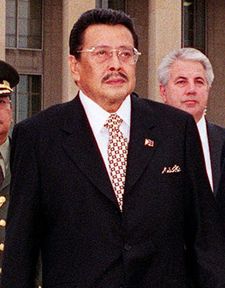 |
|
|
|
|
| In office June 30, 1998 – January 20, 2001 |
|
| Vice President | Gloria Macapagal-Arroyo |
|---|---|
| Preceded by | Fidel Ramos |
| Succeeded by | Gloria Macapagal-Arroyo |
|
|
|
| In office June 30, 1992 – June 30, 1998 |
|
| President | Fidel Ramos |
| Preceded by | Salvador Laurel |
| Succeeded by | Gloria Macapagal-Arroyo |
|
|
|
| In office June 30, 1987 – June 30, 1992 |
|
|
Mayor of San Juan
|
|
| In office December 30, 1969 – March 25, 1986 |
|
|
|
|
| Born | April 19, 1937 Tondo, Manila, Philippines |
| Political party | PMP (1991–) |
| Other political affiliations |
Nacionalista (1969–1987) Liberal Party (1987–1991) |
| Spouse(s) | Loi Pimentel |
| Alma mater | Ateneo de Manila University, Mapúa Institute of Technology |
| Profession | Actor Businessperson Politician |
| Religion | Roman Catholicism |
| Signature | |
| Website | Official website |
Joseph "Erap" Estrada (born Jose Marcelo Ejercito on 19 April 1937) was the 13th President of the Philippines, serving from 1998 until 2001. Estrada was the only president to have resigned[1][2] from office and was the first person in the Post-EDSA era to be elected both to the presidency and vice-presidency.
Estrada gained popularity as a film actor, playing the lead role in over 100 films in an acting career spanning 33 years. He leveraged his popularity as an actor to make gains in politics, serving as mayor of San Juan for seventeen years, as Senator for one term, then as Vice President of the Philippines under the administration of President Fidel Ramos.
Estrada was elected President in 1998 with a wide margin of votes separating him from the other challengers, and was sworn into the presidency on June 30, 1998. In 2000 he declared an "all-out-war" against the Moro Islamic Liberation Front and captured its headquarters and other camps[3][4]. However, allegations of corruption spawned an impeachment trial in the Senate, and in 2001 Estrada was ousted from a power grab after former Chief Justice Hilario Davide, Jr. allowed the prosecution to walk out of the impeachment court when the Senator Judges voted no in the opening of the second envelope which is not part of the impeachment complaint.
In 2007, he was sentenced by the special division of the Sandiganbayan to reclusion perpetua for plunder, but was later granted pardon by President Gloria Macapagal-Arroyo.
Contents |
Early life and career
Joseph Ejercito Estrada, was born on April 19, 1937 in Tondo, the poorest district of Manila. He belonged to an upper middle class family, and was the eighth of 10 children of Emilio Ejercito, a government engineer, and his wife Maria Marcelo.[5] He finished his primary studies at the Ateneo de Manila University. He went to Mapúa Institute of Technology to continue schooling with an engineering course, but dropped out from studies altogether two years later.
In his twenties, he began a career as a film actor. He adopted the screen name "Joseph Estrada", as his father objected to his chosen career and his decision to quit schooling.[5] He also acquired the nickname "Erap" (a play on the Tagalog word "pare", meaning buddy) from his good friend Fernando Poe, Jr..
Film
He played the lead role in more than 100 movies, and was producer of over 70 films. He was the first FAMAS Hall of Fame recipient for Best Actor (1981) and also became a Hall of Fame award-winner as a producer (1983). He often played heroes of the downtrodden classes, which gained him the admiration of a lot of the nation's many unschooled and impoverished citizens. This later proved advantageous to his political career.
In 1974 he founded the Movie Workers Welfare Foundation (Mowelfund) which helps movie makers through medical reimbursements, hospitalization, surgery and death benefits, livelihood, and alternative income opportunities and housing. Its educational arm, the Mowelfund Film Institute, has produced some of the most skilled and respected producers, filmmakers, writers and performers in both the independent and mainstream sectors of the industry since its inception in 1979.[6] He also founded, together with Dr. Guillermo De Vega, the first Metro Manila Film Festival in 1975.[7]
Early Political Career
Mayor of San Juan
Estrada entered politics in 1967 when he ran for mayor of San Juan, a municipality of Metro Manila and succeeded in only 1969 after winning an electoral protest against Dr. Braulio Sto. Domingo.[8] When Corazon Aquino assumed the presidency in 1986, all elected officials of the local government were forcibly removed and replaced by appointed officers-in-charge including then Mayor Estrada.
Senator of the Philippines
The following year, he won a seat in the Senate under the Grand Alliance for Democracy (GAD) placing 16th in the elections (out of 24 winners). As senator, Erap denounced the presence of US military bases in the country. He became chairman of the senate committee on cultural minorities and passed a bill on commission on ancestral domain.
Vice-Presidency
In 1992, Joseph Estrada ran for vice-president as the running mate of Eduardo Cojuangco, Jr. under the Nationalist People's Coalition party. Though the latter lost to former National Defense Secretary Fidel Ramos, Estrada won the vice-presidency garnering more votes than his closest opponent, Ramon Mitra, Jr.'s running mate, Marcelo Fernan.
As Vice-President, he was the chairman of President Ramos' Presidential Anti-Crime Commission (PACC). Estrada arrested criminal warlords and kidnapping syndicates[9]. He resigned as chairman of the PACC on 1997. In 1997 Vice-President Estrada, together with former President Corazon Aquino, Cardinal Jaime Sin, Senator Gloria Macapagal Arroyo and other political leaders, led an anti-charter change rally brought in an estimated half a million people to Rizal Park against the charter change moves by supporters of President Fidel Ramos[10].
1998 Presidential Elections
The 1998 presidential election campaign, like most presidential election campaigns in the Philippines, had hardly anything to do with a contest between political platforms and programs. Estrada’s political strategists and financial backers were aware that a large share of the Philippine electorate, the "masa" (the poor and undereducated masses), were looking for a leadership they could relate to. Estrada’s financial backers designed a campaign strategy that reflected Estrada’s pro-poor image that he had built up throughout his movie career. Central in the was the slogan "Erap para sa Mahirap"(Erap for the poor) that inspired the masses in the hopt that Estrada would be the President of and for the masses. Estrada's running mate, Edgardo Angara, was defeated by Gloria Macapacal-Arroyo.
Presidency
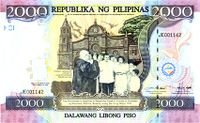
Estrada was inaugurated on June 30, 1998 in the historical town of Malolos in Bulacan province in paying tribute to the cradle of the First Philippine Republic. That afternoon the new president delivered his inaugural address at the Quirino Grandstand in Luneta. He assumed office amid the Asian Financial Crisis and with agricultural problems due to poor weather conditions, thereby slowing the economic growth to -0.6% in 1998 from a 5.2% in 1997.[11] The economy recovered by 3.4% in 1999 and 4% in 2000.[12] In 2000 he declared an "all-out-war" against the Moro Islamic Liberation Front and captured it's headquarters and other camps[4][13]. However, allegations of corruption spawned a railroaded impeachment trial in the Senate courtesy of house speaker Manuel Villar, and in 2001 Estrada was ousted from a coup after the trial was aborted.
In his Inaugural Address, Estrada said:
| “ | One hundred years after Kawit, fifty years after independence, twelve years after EDSA, and seven years after the rejection of foreign bases, it is now the turn of the masses to experience liberation. We stand in the shadow of those who fought to make us free- free from foreign domination, free from domestic tyranny, free from superpower dictation, free from economic backwardness.[14] | ” |
Domestic Policies
Foreign Policies
Economy
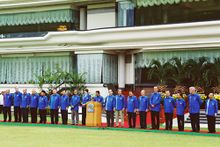
In 1998, Joseph Estrada was elected president. Even with its strong economic team, the Estrada administration failed to capitalize on the gains of the previous administration. His administration was severely criticized for cronyism, incompetence, and corruption, causing it to lose the confidence of foreign investors. Foreign investors' confidence was further damaged when, in his second year, Estrada was accused of exerting influence in an investigation of a friend's involvement in stock market manipulation. Social unrest brought about by numerous bombing threats, actual bombings, kidnappings, and other criminal activities contributed to the economy's troubles. Economic performance was also hurt by climatic disturbance that caused extremes of dry and wet weather[15]. Toward the end of Estrada's administration, the fiscal deficit had doubled to more than P100 billion from a low of P49 billion in 1998[16]. Despite such setbacks, the rate of GNP in 1999 increased to 3.6 percent from 0.1 percent in 1998, and the GDP posted a 3.2 percent growth rate, up from a low of-0.5 percent in 1998. Debt reached P2.1 trillion in 1999. Domestic debt amounted to P986.7 billion while foreign debt stood at US$52.2 billion[17].
War against the MILF
During the Ramos administration a cessation of hostilities agreement was signed between the Philippine Government and the Moro Islamic Liberation Front (MILF) in July 1997. This was continued by a series of peace talks and negotiations in Estrada administration.[4] However the MILF, an Islamic group formed in 1977, seeks to be an independent Islamic State from the Philippines, despite the agreements, a sequence of terrorist attacks with the Philippine military and the civilians still continued.[4] It was later divulged in a Senate Hearing by then Lt. Trillanes that the Military was behind these terrorist attacks to justify the "All-out-war policy" of the government and it was masterminded by Chief of Staff Angelo Reyes.<ref/http://www.philstar.com/Article.aspx?articleId=215752/> Such of those attack are 277 violations committed, kidnapping a foreign priest, namely Father Luciano Benedetti, the occupying and setting on fire of the municipal hall of Talayan, Maguindanao; the takeover of the Kauswagan Municipal Hall; the bombing of the Lady of Mediatrix boat at Ozamiz City; and the takeover of the Narciso Ramos Highway. By doing so, they inflicted severe damage on the country's image abroad, and scared much-needed investments away.Because of this, on March 21, 2000, President Joseph Estrada declared an "all-out-war" against the MILF. During the war the Catholic Bishops' Conference of the Philippines (CBCP) asked Estrada to have a cease-fire with MILF, but Estrada opposed the idea arguing that a cease-fire would cause more terrorist attacks. For the next three months of the war, Camp Abubakar, headquarters of the MILF, fell along with other 13 major camps and 43 minor camps, and then all of which became under controlled by the government. The MILF leader Hashim Salamat fled the country and went to Malaysia. The MILF later declared a Jihad on the government. On July 10 of the same year, the President went to Minadanao and raised the Philippine flag symbolizing victory. After the war the President said, "... will speed up government efforts to bring genuine and lasting peace and development in Mindanao". In the middle of July the president ordered the military to arrest top MILF leaders.[18]
In his state of the nation address, popularly called "SONA", the president highlighted his vision for Mindanao:
- The first is to restore and maintain peace in Mindanao—because without peace, there can be no development.
- The second is to develop Mindanao—because without development, there can be no peace.
- The third is to continue seeking peace talks with the MILF within the framework of the Constitution—because a peace agreed upon in good faith is preferable to a peace enforced by force of arms.
- And the fourth is to continue with the implementation of the peace agreement between the government and the Moro National Liberation Front, or MNLF—because that is our commitment to our countrymen and to the international community.
In addition to this the president said his administration can move with more speed in transforming Mindanao into a progressive economic center.[18] High on the list of priorities was the plight of MILF guerrillas who were tired of fighting and had no camps left to report to. On October 5, 2000 the first massive surrender of 669 MILF mujahideen led by the renegade vice mayor of Marugong, Lanao del Sur Malupandi Cosandi Sarip and seven other battalion commanders, surrendered to President Joseph Estrada at the 4th ID headquarters in Camp Edilberto Evangelista, Bgy. Patag, Cagayan de Oro City. They were followed shortly by a second batch of 855 surrenderees led by MILF Commander Sayben Ampaso on Dec. 29, 2000.[19]
Controversies
Corruption charges and impeachment
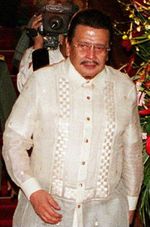
In October 2000, Ilocos Sur governor Luis "Chavit" Singson, a close friend of Estrada, alleged that he had personally given the President P400 million as payoff from jueteng hidden in a bank account known as "Jose Velarde" – a grassroots-based numbers game, as well as P180 million from the government price subsidy for the tobacco farmers' marketing cooperative after President Estrada ordered a full blown investigation into Chavit Singson's alleged misuse of millions of pesos in public funds. Singson's allegation caused controversy across the nation, which culminated in the House of Representatives' filing of an impeachment case against Estrada on November 13, 2000. House Speaker Manny Villar fast-tracked the impeachment complaint. The impeachment suit was brought to the Senate and an impeachment court was formed, with Chief Justice Hilario Davide, Jr. as presiding officer. Estrada, pleading “not guilty”.
This was the first time Filipinos would witness, through radio and television, an elected president stand in trial and face possible impeachment with full media coverage. During the trial, the prosecution presented witnesses and alleged evidences to the impeachment court regarding Estrada's alleged involvement in jueteng. The existence of secret bank accounts which he allegedly uses for receiving payoffs was also brought affront.
EDSA II
Protests
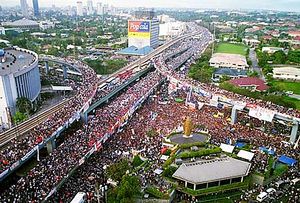
On the evening of January 16, 2001, the impeachment court voted not to open an envelope that was alleged to contain incriminating evidence against the president simply because it was not part of the impeachment complaint. The final vote was 11-10, in favor of keeping the envelope closed. The prosecution panel (of congressmen and lawyers) walked out of the Impeachment Court in protest of this vote. The 11 senators who voted not to open the envelope are known as the "Craven Eleven." That night, anti-Estrada protesters gathered in front of the EDSA Shrine at Epifanio de los Santos Avenue, not too far away from the site of the 1986 People Power Revolution that overthrew Ferdinand Marcos.
On January 19, 2001, Armed Forces of the Philippines Chief of Staff Angelo Reyes, seeing the political upheaval throughout the country, "decided to withdraw his support" from the president and transfer his allegiance to the vice president, Gloria Macapagal-Arroyo.
Resignation
The following day, the Supreme Court declared that the seat of presidency was vacant, saying that Estrada "constructively resigned his post". At noon, the Chief Justice swore in Gloria Macapagal-Arroyo, as President of the Philippines.
Post-Presidency
Estrada returned to his old home in San Juan. He maintained that he never resigned, implying that Arroyo's government was illegitimate.
The new government ceated a special court and charged him with plunder and had him arrested in April. Filipino supporters marched to the EDSA Shrine demanding Estrada's release and his reinstatement as president but were dispersed by high-grade teargas and warning shots from automatic rifles. On the morning of May 1, the protesters marched straight to Malacanang Palace. Violence erupted and the government declared a State of Rebellion. Many Filipino protesters were badly injured and arrested, including politicians. The government called out the military and was able to quell the demonstration with teargas and automatic rifles. The bloody uprising came to be known as EDSA III.
Estrada was initially detained at the Veteran's Memorial Medical Center in Quezon City and then transferred to a military facility in Tanay, Rizal, (This initiated EDSA III where almost 3million supporters of Estrada Marched to Edsa shrine and then a few days later - to Malacanang) but he was later transferred to a nearby vacation home, virtually in house arrest. Under Philippine law, plunder has a maximum penalty of death, however since the death penalty was repealed.
Trial
On September 12, 2007, the Sandiganbayan finally gave its decision, finding Estrada not guilty on his perjury case but guilty of plunder "beyond reasonable doubt." He was sentenced to Reclusión perpetua. He was thus the first Philippine President who was impeached and then convicted.[20]
On September 26, 2007, Joseph Estrada appealed by filing a 63-page motion for reconsideration of the Sandiganbayan judgment penned by Teresita de Castro (submitting 5 legal grounds).[21][22] Estrada alleged that the court erred "when it convicted him by acquitting his alleged co-conspirators."[23]
On October 5, 2007, the Sandiganbayan's Special Division ruled to have set for October 19, oral argument (instead of a defense reply) on Joseph Estrada’s motion for reconsideration. Estrada asked for court permission to attend the hearing, since it ordered the prosecution to file comment before October 11.[24]
Perjury case
The Sandiganbayan's special division, on June 27, 2008, ordered Estrada to file comment within 10 days, on the motion of the Ombudsman's Special Prosecutor to re-open the trial of his perjury case regarding 1999 statement of assets, liabilities and net worth (SALN). The court will also resolve Banco de Oro's (formerly Equitable PCI Bank), plea that it cannot determine "without hazard to itself" who to turn over to the P1.1 billion Jose Velarde assets due to claims by Wellex Group / William Gatchalian and a Bureau of Internal Revenue stay order.[25]
Pardon and release from detention
On October 22, 2007, Acting Justice Secretary Agnes Devanadera stated that Joseph Estrada is seeking a “full, free, and unconditional pardon” from President Gloria Macapagal-Arroyo. Estrada's lawyer Jose Flaminiano wrote Arroyo: "The time has come to end President Estrada's fight for justice and vindication before the courts. Today [Monday], we filed a withdrawal of his Motion for Reconsideration." Estrada, 70, stressed the "delicate condition" of his mother in asking for pardon.[26]
On October 25, 2007, President Gloria Macapagal-Arroyo granted executive clemency to Joseph Estrada based on the recommendation by the Department of Justice (DoJ). Acting Executive Secretary and Press Secretary Ignacio R. Bunye quoted the signed Order: "In view hereof in pursuant of the authority conferred upon me by the Constitution, I hereby grant Executive clemency to Joseph Ejercito Estrada, convicted by the Sandiganbayan of plunder and imposed a penalty of reclusion perpetua. He is hereby restored to his civil and political rights." Bunye noted that Estrada committed in his application not to seek public office, and he would be free from his Tanay resthouse on October 26, noon.[27][28][29] On October 26, 2007, after almost 7 years of detention, Joseph Estrada was finally released after the Sandiganbayan promulgated the historical Resolution.[30]
Activities
When he was released he gave a message to the Filipino people that he can once again help the lives of the people especially the poor. He also stated that he made errors as a public servant but he assured them that corruption was not one of them. After the release he had a series nationwide tour called "Lakbay Pasasalamat"[31][32] (Thank you tour) and during those trips he thanked the people for their support and gave them relief goods such as food, medicines and clothing[8][33][34]. In politics, he is convincing leaders of the opposition to have unity in the party or, he said, he will run.[35]
2010 Presidential election
Joseph Estrada has stated in interviews that he would be willing to run for the opposition in the event that they are unable to unite behind a single candidate.[36][37] Fr. Joaquin Bernas and Christian Monsod, members of the constitutional commission that drafted the 1987 Constitution, have stated that the constitution clearly prohibits any elected president from seeking a second term at any point in time.[38] Romulo Macalintal, election counsel of President Arroyo, has clarified that the constitutional ban doesn't prevent Estrada from attaining the presidency in the event that he were to be elevated from the vice-presidency, for example.[39] However, Rufus Rodriquez, one of Estrada's lawyers, claims that the former president is within his rights to do so because the prohibition banning re-election only applies to the incumbent president.[36]
On October 22, 2009 former President Joseph Estrada announced that he would run again for president with Makati City Mayor Jejomar Binay as his running mate[40].
His Senatorial lineup includes: Francisco Tatad, Juan Ponce Enrile, Jinggoy Estrada and Joey de Venecia.
Electoral history
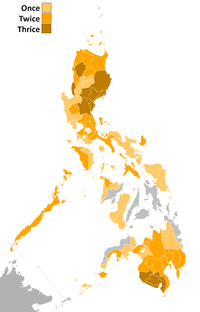
- 1987 Senate election
- Joseph Estrada (GAD): 10,029,978 (14th, 24 candidates with the highest number of votes win the 24 seats in the Senate)
- 1992 vice presidential election
- Joseph Estrada (PMP): 6,739,738 (33.00%)
- Marcelo Fernan (LDP): 4,438,494 (21.74%)
- Emilio Osmeña (Lakas-NUCD): 3,362,467 (16.47%)
- Ramon Magsaysay, Jr. (PRP): 2,900,556 (14.20%)
- Aquilino Pimentel, Jr. (PDP-Laban): 2,023,289 (9.91%)
- Vicente Magsaysay (KBL): 699,895 (3.43%)
- Eva Estrada-Kalaw (Nacionalista): 255,730 (1.25%)
- 1998 presidential election
- Joseph Estrada (LAMMP): 10,722,295 (39.86%)
- Jose de Venecia (Lakas-NUCD-UMDP): 4,268,483 (15.87%)
- Raul Roco (Aksyon Demokratiko): 3,720,212 (13.83%)
- Emilio Osmeña (PROMDI): 3,347,631 (12.44%)
- Alfredo Lim (Liberal):2,344,362 (8.71%)
- Renato de Villa (Reporma-LM): 1,308,352 (4.86%)
- Miriam Defensor Santiago )PRP): 797,206 (2.96%)
- Juan Ponce Enrile (Independent): 343,139 (1.28%)
- Santiago Dumlao (Kilusan para sa Pambansang Pagpapanibago): 32,212 (0.12%)
- Manuel Morato (Partido Bansang Marangal): 18,644 (0.07%)
- 2010 presidential election:
- Benigno Aquino III (Liberal): 15,208,678 (42.08%)
- Joseph Estrada (PMP): 9,487,837 (26.25%)
- Manny Villar (Nacionalista): 5,573,835 (15.42%)
- Gilberto Teodoro (Lakas Kampi CMD): 4,095,839 (11.33%)
- Eddie Villanueva (Bangon Pilipinas): 1,125,878 (3.12%)
- Richard Gordon (Bagumbayan-VNP): 501,727 (1.39%)
- Nicanor Perlas (independent): 54,575 (0.15%)
- Jamby Madrigal (independent): 46,489 (0.13%)
- John Carlos de los Reyes (Ang Kapatiran): 44,244 (0.12%)
Personal life
Family
Estrada is the first president to be a celebrity. He is also the first mustache president. Estrada is married to (the former Doctor and first lady-turned-senator) Luisa Pimentel and had three children by her:
- Jose Ejercito, Jr. (better known as "Jinggoy Estrada"; former Mayor of San Juan turned Senator/married to Precy Vitug)
- Jackie Ejercito (married to Beaver Lopez, son of Meralco chairman Manuel Lopez)
- Jude Ejercito (married to Weng Ocampo)
Joseph Estrada met his wife Loi while working as an orderly at the National Center for Mental Health (NMCH) in Mandaluyong City.
Descendants
Several of Ejercito's descendants became prominent political figures in their own right:
- George Estregan (Emilio Ejercito Jr. in real life), brother of former president and former actor.
- E.R. Ejercito (Jorge Estregan Jr. in screen name), nephew of former president, former actor turned politician.
- Gary Estrada, former president's grandson, current actor and board member.
- Gherome Ejercito, former president's grandson and former basketball player.
- JV Ejercito, former president's son and wedlock by Guia Gomez, former San Juan City mayor turned Congressman.
- Josephine Rose Ejercito, who was recently crowned as Mutya ng Kalookan, is not a daughter of Mr. Estrada.
In popular culture
Since the beginning of his political career, Estrada has been the butt of many jokes in the Philippines. Majority of the jokes about him center around his limited English vocabulary, while others focus on his corruption scandals. During his presidential campaign in 1998, Estrada authorized the distribution of the joke compilation book ERAPtion: How to Speak English Without Really Trial.[41]
Awards and honors
- 1962 FAMAS Best Actor for Markang Rehas[42][43]
- 1964 FAMAS Best Actor for Geron Busabos[42][43]
- 1966 FAMAS Best Actor for Ito ang Pilipino[42][43]
- 1969 FAMAS Best Actor for Patria Adorada[42][43]
- 1971 Outstanding Mayor and foremost Nationalist by the Inter-Provincial Information Service[8]
- 1972 One of the Ten Outstanding Young Men (TOYM) in Public Administration by the Philippine Jaycees[8]
- 1981 FAMAS Best Actor for Kumander Alibasbas[42][43]
- 1981 FAMAS Hall of Fame[42][44]
- 2007 Most Outstanding Citizen of San Juan
References
- ↑ [1]
- ↑ [2]
- ↑ Philippine Military Takes Moro Headquarters
- ↑ 4.0 4.1 4.2 4.3 Speech of Former President Estrada on the GRP-MORO Conflict - Philippine Human Development Network
- ↑ 5.0 5.1 Malaya, J. Eduardo; Jonathan E. Malaya (2004). ...So Help Us God: The Presidents of the Philippines and Their Inaugural Addresses. Pasig City: Anvil Publishing. pp. 277–299. ISBN 971-27-1487-X.
- ↑ Martinez-Belen, Crispina. (2009, March 27). Mowelfund marks 35th year. The Manila Bulletin. Retrieved September 28, 2009 from http://mb.com.ph
- ↑ YouTube - to live for the masses
- ↑ 8.0 8.1 8.2 8.3 President Joseph Ejercito Estrada, A Biography
- ↑ The rise and fall of Joseph Estrada - Yehey! News
- ↑ GMANews.TV - Gloria and cha-cha - Research - Official Website of GMA News and Public Affairs - Latest Philippine News - BETA
- ↑ Philippines : Gov.Ph : The Official Government Portal of the Republic of the Philippines - General Information
- ↑ Abaya, Antonio. (2007, Jan. 17). GMAs Successes. Retrieved September 28, 2009.
- ↑ Philippine Military Takes Moro Headquarters
- ↑ Untitled Document
- ↑ [3]
- ↑ [4]
- ↑ Records prove Estrada’s achievements - INQUIRER.net, Philippine News for Filipinos
- ↑ 18.0 18.1 "Philippine Military Takes Moro Headquarters". English.peopledaily.com.cn. July 10, 2000. http://english.peopledaily.com.cn/english/200007/10/eng20000710_45067.html. Retrieved March 23, 2009.
- ↑ American Chronicle | AFP-MILF 2000 War in Mindanao Remembered
- ↑ "Erap guilty of plunder, sentenced to reclusion perpetua", gmanews.tv, September 12, 2007.
- ↑ Monstersandcritics.com, Philippines' ex-president Estrada appeals conviction for plunder
- ↑ English.people.com, Convicted Philippine ex-president files reconsideration motion
- ↑ Inquirer.net, Estrada asks Sandiganbayan to reverse conviction, Cites acquittal of co-accused
- ↑ ManilaBulletin, Erap wants to attend Sandigan oral arguments
- ↑ newsinfo.inquirer.net, Estrada told to reply to request to start perjury trial
- ↑ IHT, Ousted Philippine president withdraws appeal for his plunder conviction, seeks pardon
- ↑ news.monstersandcritics.com, Philippine leader pardons ex-president Estrada
- ↑ Inquirer.net, Arroyo grants pardon to Estrada
- ↑ Gmanews.tv, Estrada granted executive clemency
- ↑ Inquirer.net, Sandigan approves Estrada release
- ↑ Photo Release - Lakbay Pasasalamat
- ↑ ERAP TO ENDORSE WHOEVER TOPS SURVEY IN 2010
- ↑ GMANews.TV - QTV: Erap gives gift bags as part of birthday celebration - Video - Official Website of GMA News and Public Affairs - Latest Philippine News - BETA
- ↑ GMANews.TV - Estrada distributes food, clothes, medicine in Quezon City - Video - Official Website of GMA News and Public Affairs - Latest Philippine News - BETA
- ↑ GMANews.TV - Saksi: Erap bares list of possible senatorial bets for 2010 - Video - Official Website of GMA News and Public Affairs - Latest Philippine News - BETA
- ↑ 36.0 36.1 Clapano, Jose Rodel (January 7, 2008). "Erap can run? Binay ready for 2010; Noli open as opposition's bet". Philippine Star. http://www.newsflash.org/2004/02/hl/hl106874.htm. Retrieved January 6, 2009.
- ↑ "Erap gives up on opposition unity, decides to run himself". Philippine Daily Inquirer. September 26, 2009. http://newsinfo.inquirer.net/inquirerheadlines/nation/view/20090926-226941/Erap-gives-up-on-opposition-unity-decides-to-run-himself. Retrieved September 26, 2009.
- ↑ de Quiros, Conrado (January 8, 2008). "Comedy, tragedy". Philippine Daily Inquirer. http://www.inquirer.net/specialreports/theestradawatch/view.php?db=1&article=20080108-110964. Retrieved January 6, 2009.
- ↑ Punay, Edu (December 23, 2008). "GMA election lawyer insists Erap can't run in 2010". Philippine Star. http://www.philstar.com/Article.aspx?ArticleId=426264&publicationSubCategoryId=63. Retrieved January 6, 2009.
- ↑ [5]
- ↑ Hot Manila - Joked to Death
- ↑ 42.0 42.1 42.2 42.3 42.4 42.5 [6]
- ↑ 43.0 43.1 43.2 43.3 43.4 [7]
- ↑ [8]
External links
- Official Website of Joseph "Erap" Estrada
- Office of the President (Archived-Estrada Administration)
- Joseph Estrada Curriculum Vitae
- Malacañang Museum Official Biography
- Official Youtube Channel of Joseph Estrada
- Joseph Estrada at the Internet Movie Database
| Political offices | ||
|---|---|---|
| Preceded by Salvador Laurel |
Vice President of the Philippines 1992–1998 |
Succeeded by Gloria Macapagal-Arroyo |
| Preceded by Fidel Ramos |
President of the Philippines 1998–2001 |
Succeeded by Gloria Macapagal-Arroyo |
|
||||||||||||||||||
|
|||||
|
|||||
|
|||||||||||||||||||||||